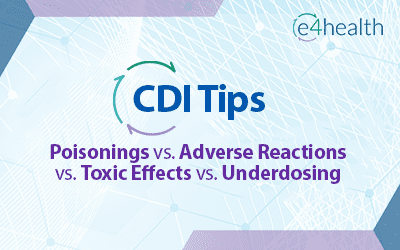Debridement Excisional Debridement Definition: The surgical removal or cutting away of devitalized tissue, necrosis, and slough. Non-Excisional Debridement Definition: The nonoperative brushing, irrigating, scrubbing, or washing of devitalized tissue, necrosis,...
The latest information to keep updated for advanced coding.
CDI Tips & Friendly Reminders: Coma
Mar 15, 2024 | CDI, Coding + CDI, Coding Tips, Education & Training, News
ComaDefinition: Deep state of unconsciousness where patients are unable to move or be aware of or respond to their surroundings with loss of thinking abilities however retain non-cognitive function and normal sleep patterns.Diagnostic CriteriaA comprehensive...
Coding Tips: New Codes for Sickle Cell Disease with Dactylitis
Mar 6, 2024 | Coding, Coding Tips, Education & Training, News
New Codes for Sickle Cell Disease with Dactylitis (Valid for October 1, 2023 discharges)• D57.04 Hb-SS disease with dactylitis• D57.214 Sickle-cell/Hb-C disease with dactylitis• D57.414 Sickle-cell thalassemia, unspecified, with dactylitis• D57.434 Sickle-cell...
Coding Tips: Complication Comorbidity Update
Feb 19, 2024 | Coding, Coding + CDI, Coding Tips, Education & Training, News
Complication Comorbidity UpdateSocial Determinants of Health (SDOH) codes Z59.00, Homelessness unspecified, Z59.01, Sheltered homelessness and Z59.02, Unsheltered homelessness will be considered CC’s (complication/comorbidity) beginning with October 1, 2023...
CDI Tips & Friendly Reminders: Pathological Fractures
Feb 15, 2024 | CDI, Coding + CDI, Coding Tips, Education & Training, News
Pathological FracturesDefinition: A bone fracture that occurs without adequate trauma, caused by an underlying disease.Diagnostic CriteriaIdentified in Radiology/Diagnostic Imaging such as X-Ray, CT, MRI, or bone scans. There are various underlying causes for...
Coding Tips: New Code for Resistant Hypertension
Feb 7, 2024 | Coding, Coding Tips, Education & Training, News
New Code for Resistant Hypertension (Valid for October 1, 2023 discharges)I1A.0 Resistant hypertension May be documented as: Apparent treatment resistant hypertension, Treatment resistant hypertension, True resistant hypertension. The ICD-10-CM Tabular instruction...
CDI Tips & Friendly Reminders: Hypertensive Crisis
Jan 22, 2024 | CDI, Coding + CDI, Coding Tips, Education & Training, News
Hypertensive CrisisDefinition: HTN: Systolic blood pressure (SBP) of 130mm Hg or more and/or diastolic blood pressure (DBP) of more than 80mm Hg HTN Crisis: Generic term to describe hypertensive urgency or hypertensive emergency, typically seen with elevated blood...
Decoding V28 Transition: Key Takeaways from Journal of AHIMA
Dec 21, 2023 | CDI, Coding, Coding + CDI, Coding Tips, Education & Training, Industry Insights, News
Medicare Advantage is on the brink of a significant restructuring as it transitions from V24 to V28 of the hierarchical condition categories (HCCs) risk adjustment model. In a recent Journal of AHIMA article, I partnered with Jeanie Heck, BBA, CCS, Education...
CDI Tips & Friendly Reminders: Respiratory Failure
Dec 18, 2023 | CDI, Coding + CDI, Coding Tips, Education & Training, News
Respiratory FailureDefinition: Syndrome where the respiratory systems fail in either or both the gas exchange function or oxygenation and carbon dioxide elimination. Recognized as either hypoxemic or hypercapnic.Coding Considerations:Review the circumstances of...
Enroll in e4health’s 2024 Risk Adjustment Webinar Series for FREE CEUs
Dec 1, 2023 | CDI, Coding, Coding + CDI, Coding Tips, News, Webinar
The first part of the series, “Medicare Advantage HCC Model Changes From v24 to v28” is a deep dive into the upcoming HCC model changes. This webinar is approved for 1.0 AHIMA and AAPC CEU. The following six parts of the series are designed to provide additional...
CDI Tips & Friendly Reminders: Poisonings vs. Adverse Reactions vs. Toxic Effects vs. Underdosing
Nov 15, 2023 | CDI, Coding + CDI, Coding Tips, Education & Training, News
Poisonings vs. Adverse Reactions vs. Toxic Effects vs. Underdosing DefinitionPoisoning: reaction to the improper use of a medication. This can include either:Wrong substanceWrong doseWrong personWrong Route of administrationTaken in combination of alcohol, illicit...
Coding Tip: Exagamglogene autotemcel
May 21, 2023 | Coding Tips, Education & Training
Exagamglogene autotemcel (Exa-cel) (aka CTX001™) is a genetically modified cell therapy that is used to increase fetal hemoglobin (HbF) in patients with sickle-cell disease (SCD) and transfusion-dependent beta-thalassemia (TDT). Exagamglogene autotemcel is an...









